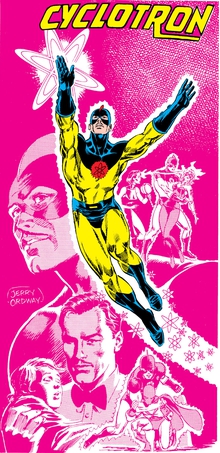The Atom is a name shared by five superheroes appearing in American comic books published by DC Comics.
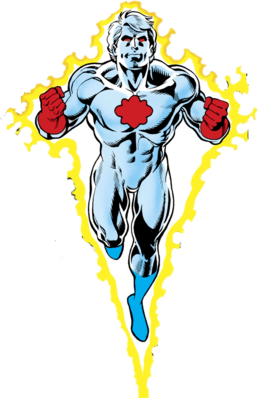
Captain Atom is the name of several superheroes appearing in American comic books, initially owned by Charlton Comics before being acquired in the 1980s by DC Comics. All possess some form of energy-manipulating abilities.

Ultra-Humanite is a supervillain appearing in American comic books published by DC Comics. He first appeared as a recurring adversary of Superman, and was among the first villains faced by him. He was designed to be the polar opposite of Superman; while Superman is a hero with superhuman strength, Ultra-Humanite is a criminal mastermind who has a crippled body but a highly advanced intellect. The Ultra-Humanite served as Superman's nemesis until Alexei Luthor and his Silver Age counterpart Lex Luthor were introduced in the comics. The origins of the super-criminal known as the Ultra-Humanite are shrouded in mystery. Even he claims not to remember his true name or appearance and attributes his vast intellect and mental prowess to scientific experiments of an unknown nature.
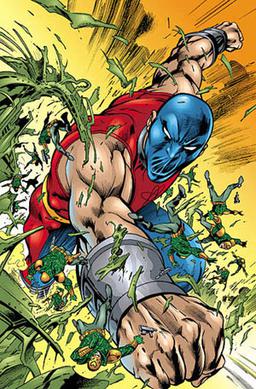
Albert Rothstein is a superhero appearing in American comic books published by DC Comics. Atom Smasher is known for his power of growth and super strength.
The American Crusader is a superhero who originally appeared in Thrilling Comics #19. He appeared in almost every issue until #41.

The Psycho-Pirate is the name of two supervillains appearing in American comic books published by DC Comics.

Kobra is the name used by two supervillains published by DC Comics. The Jeffrey Burr incarnation of Kobra and his brother Jason first appeared in Kobra #1, and were created by Jack Kirby. Jason Burr debuted as Kobra in Faces of Evil: Kobra #1 by Ivan Brandon and Julian Lopez. The Kobra identity is later established as an international terrorist organization that frequently clashes with superheroes associated with the Justice League.
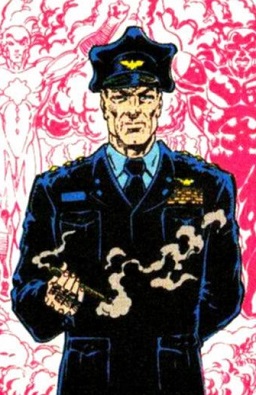
General Wade Eiling, sometimes known as The General, is a fictional character appearing in American comic books published by DC Comics.

Mantis is a fictional supervillain appearing in comic books published by DC Comics, part of Jack Kirby's New Gods series.
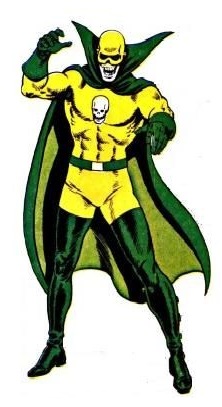
The Atomic Skull is a supervillain in American comic books published by DC Comics, commonly as an enemy of Superman. The character first appeared in 1978.

Tangent Comics is a DC Comics imprint created in 1997, developed from ideas by Dan Jurgens. The line, formed from 18 one-shots, focused on creating all-new characters using established DC names, such as the Joker, Superman, and the Flash. Contrasting the Tangent Universe with the DC Universe, Jurgens commented:
The Tangent Universe tells the story of an Earth greatly influenced by the presence of super-powered beings. While the DCU Earth is essentially the same as our own, no more advanced in terms of technology or communications despite the existence of those qualities within the super-powered community, Earth Tangent is greatly influenced by all of that. Earth Tangent's economic, geographic and political landscapes are defined by the superhero community, whereas in the DCU those aspects exist unaffected by the superhero community.
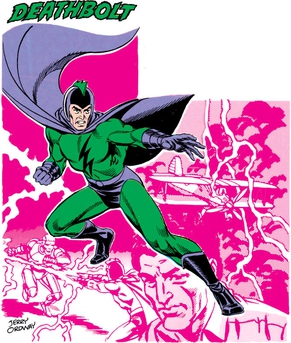
Deathbolt is a supervillain appearing in American comic books published by DC Comics. He was created by the Ultra-Humanite to fight the All-Star Squadron.

Magog is a fictional character appearing in comic books published by DC Comics, generally as an enemy and foil to Superman. He first appeared in Kingdom Come #1, and was created by Mark Waid and Alex Ross. In 2009, Magog was ranked as IGN's 75th-greatest comic book villain of all time.
Firebrand is a name of different characters appearing in American comic books published by DC Comics.

Al Pratt is a fictional character appearing in American comic books published by DC Comics. He is the first character to use the name Atom. He initially had no superpowers and was originally a diminutive college student and later a physicist, usually depicted as a "tough-guy" character. Al Pratt is also the father of Damage and godfather of Atom Smasher.
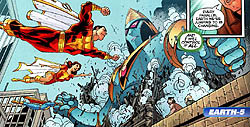
Mister Atom is a fictional comic book supervillain, a radioactive robot who is regularly seen as an enemy of Captain Marvel. The character first appeared in Captain Marvel Adventures #78 in November 1947. Along with other members of Captain Marvel's rogues' gallery, Mister Atom was recruited by Mister Mind to be part of the second Monster Society of Evil in 1973.

Johnny Quick is a Golden Age DC Comics character with the power of superhuman speed. The character first appeared in More Fun Comics #71. After his More Fun run ended in issue #107, he was moved to Adventure Comics with issue #103. He remained as a regular feature in Adventure until issue #207.
Delores Winters is a DC Comics character, originally named Dolores Winters. Until recently her main role in DC Universe history has been as a body occupied by the Ultra-Humanite in the 1940s, but she has made more significant appearances in current continuity.
Brain Wave is a supervillain appearing in the DC Comics Universe, a recurring foe of the Justice Society of America and a founding member of the Injustice Society; he is also the father of the superhero Brainwave.
